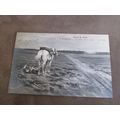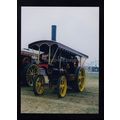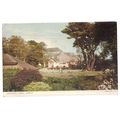London - Richmond Bridge - local art postcard c.1980s
- Condition : Used
- Dispatch : 2 Days
- Brand : None
- ID# : 180041519
- Quantity : 1 item
- Views : 187
- Location : United Kingdom

- Seller : justthebook (+1704)
- Barcode : None
- Start : Wed 24 Apr 2019 18:32:37 (EDT)
- Close : Run Until Sold
- Remain : Run Until Sold
Checks/Cheques
 for 1 item(s) edit
for 1 item(s) edit
Shipping Calculator
More Listings from This Seller view all
Seller's Description
- Postcard
- Picture / Image: Richmond Bridge - from a watercolour by Ewa Wnek-Webb
- Publisher: Artistic Treasures of Richmond
- Postally used: no
- Stamp: n/a
- Postmark(s): n/a
- Sent to: n/a
- Notes / condition:
Please ask if you need any other information and I will do the best I can to answer.
Image may be low res for illustrative purposes - if you need a higher definition image then please contact me and I may be able to send one. No cards have been trimmed (unless stated).
------------------------------------------------
Postage & Packing:
Postage and packing charge should be showing for your location (contact if not sure).
No additional charges for more than one postcard. You can buy as many postcards from me as you like and you will just pay the fee above once. Please wait for combined invoice. (If buying postcards with other things such as books, please contact or wait for invoice before paying).
Payment Methods:
UK - PayPal, Cheque (from UK bank) or postal order
Outside UK: PayPal ONLY (unless otherwise stated) please. NO non-UK currency checks or money orders (sorry).
NOTE: All postcards are sent in brand new stiffened envelopes which I have bought for the task. These are specially made to protect postcards and you may be able to re-use them. In addition there are other costs to sending so the above charge is not just for the stamp!
I will give a full refund if you are not fully satisfied with the postcard.
----------------------------------------------
Text from the free encyclopedia WIKIPEDIA may appear below to give a little background information (internal links may not work) :
*************
Richmond Bridge is an 18th-century stone arch bridge that crosses the River Thames at Richmond, connecting the two halves of the present-day London Borough of Richmond upon Thames. It was designed by James Paine and Kenton Couse.
The bridge, which is a Grade I listed,[1] was built between 1774 and 1777, as a replacement for a ferry crossing which connected Richmond town centre on the east bank with its neighbouring district of East Twickenham to the west. Its construction was privately funded by a tontine scheme, for which tolls were charged until 1859. Because the river meanders from its general west to east direction, flowing from southeast to northwest in this part of London, what would otherwise be known as the north and south banks are often referred to as the "Middlesex" (Twickenham) and "Surrey" (Richmond) banks respectively, named after the historic counties to which each side once belonged.
The bridge was widened and slightly flattened in 1937–40, but otherwise still conforms to its original design. The eighth Thames bridge to be built in what is now Greater London, it is today the oldest surviving Thames bridge in London.
The small town of Sheen on the Surrey bank of the Thames, 10 miles (16 km) west of the City of London or 16 miles (26 km) by river, had been the site of a royal palace since 1299. After it was destroyed by fire in 1497, Henry VII built a new palace on the site, naming it Richmond Palace after his historic title of Earl of Richmond, and the central part of Sheen became known as Richmond.[4]
Although a ferry had almost certainly existed at the site of the present-day bridge since Norman times,[5] the earliest known crossing of the river at Richmond dates from 1439.[6] The service was owned by the Crown, and operated by two boats, a small skiff for the transport of passengers and a larger boat for horses and small carts;[4] the Twickenham Ferry, slightly upstream, was also in service from at least 1652.[7] However, due to the steepness of the hill leading to the shore-line on the Surrey side neither ferry service was able to transport carriages or heavily laden carts,[8] forcing them to make a very lengthy detour via Kingston Bridge.[4]
In the 18th century Richmond and neighbouring Twickenham on the opposite bank of the Thames, both of which were distant from London but enjoyed efficient transport links to the city via the river, became extremely fashionable, and their populations began to grow rapidly.[4] As the ferry was unable to handle large loads and was often cancelled due to weather conditions, the river crossing became a major traffic bottleneck.[9]
Local resident William Windham had been sub-tutor to Prince William, Duke of Cumberland, and was the former husband of Mary, Lady Deloraine, mistress to George II.[10] As a reward for his services, George II leased Windham the right to operate the ferry until 1798.[10][11] Windham sub-let the right to operate the ferry to local resident Henry Holland.[10] With the ferry unable to serve the demands of the area, in 1772 Windham sought Parliamentary approval to replace the ferry with a wooden bridge, to be paid for by tolls.[4]
The plans for a wooden bridge proved unpopular, and in 1772 the Richmond Bridge Act was passed by Parliament, selecting 90 commissioners, including landscape architect Lancelot "Capability" Brown, historian and politician Horace Walpole and playwright and actor David Garrick, to oversee the construction of a stone bridge on the site of the ferry. The Act stipulated that no tax of any sort could be used to finance the bridge, and fixed a scale of tolls, ranging from ½d for a pedestrian to 2s 6d for a coach drawn by six horses (about 50p and £15 respectively in 2018).[12][13] Henry Holland was granted £5,350 (about £623,900 in 2018) compensation for the loss of the ferry service.[12][13] The commission appointed James Paine and Kenton Couse to design and build the new bridge.[14]
Listing Information
| Listing Type | Gallery Listing |
| Listing ID# | 180041519 |
| Start Time | Wed 24 Apr 2019 18:32:37 (EDT) |
| Close Time | Run Until Sold |
| Starting Bid | Fixed Price (no bidding) |
| Item Condition | Used |
| Bids | 0 |
| Views | 187 |
| Dispatch Time | 2 Days |
| Quantity | 1 |
| Location | United Kingdom |
| Auto Extend | No |











![GERMANY BUND [1955] MiNr 0210 ( O/used ) (3)](https://pic.ebid.net/upload_small/2/6/3/1562670691-8799-7.jpg)

![Michael Schumacher Cufflinks [40487206]](https://pic.ebid.net/upload_small/5/8/1/1445921239-15544-30.jpg)






